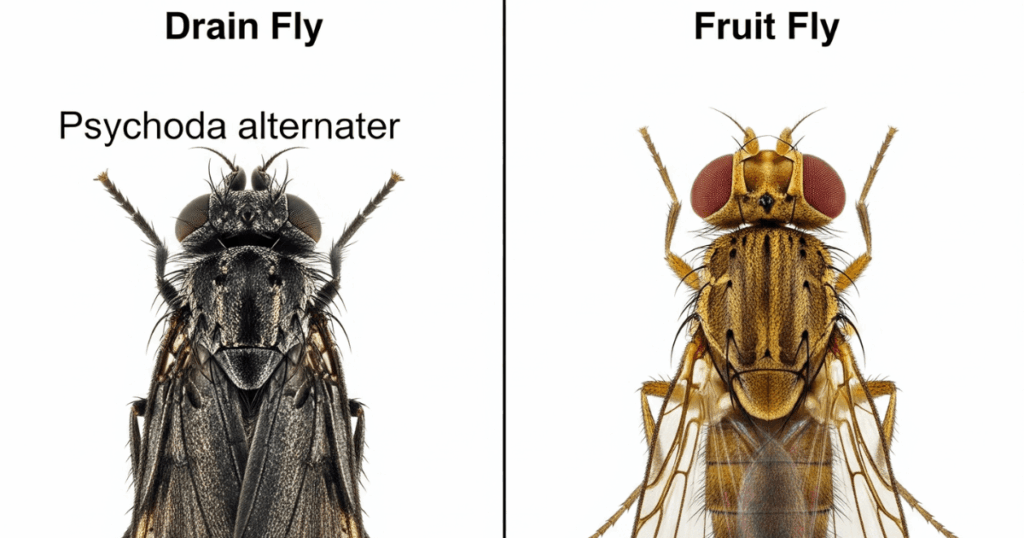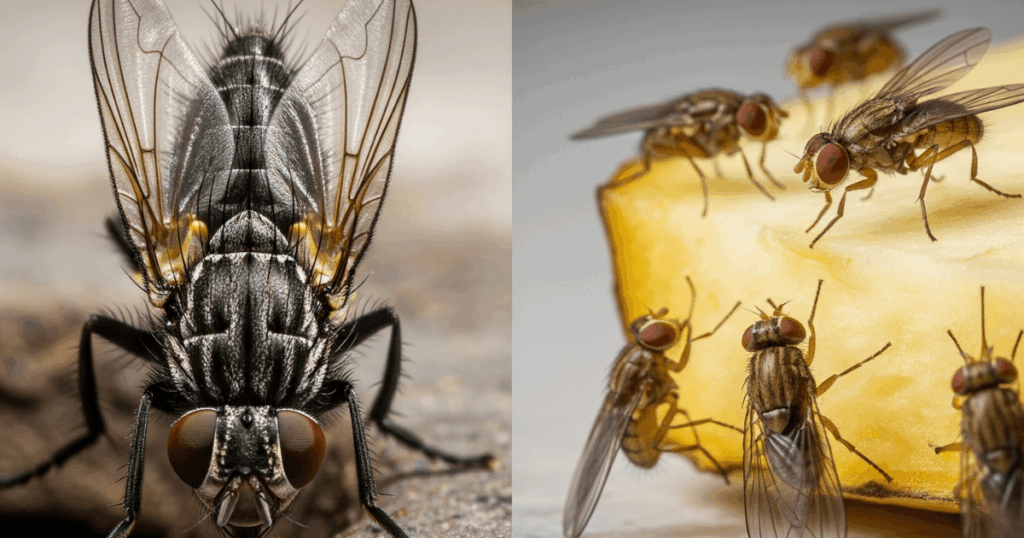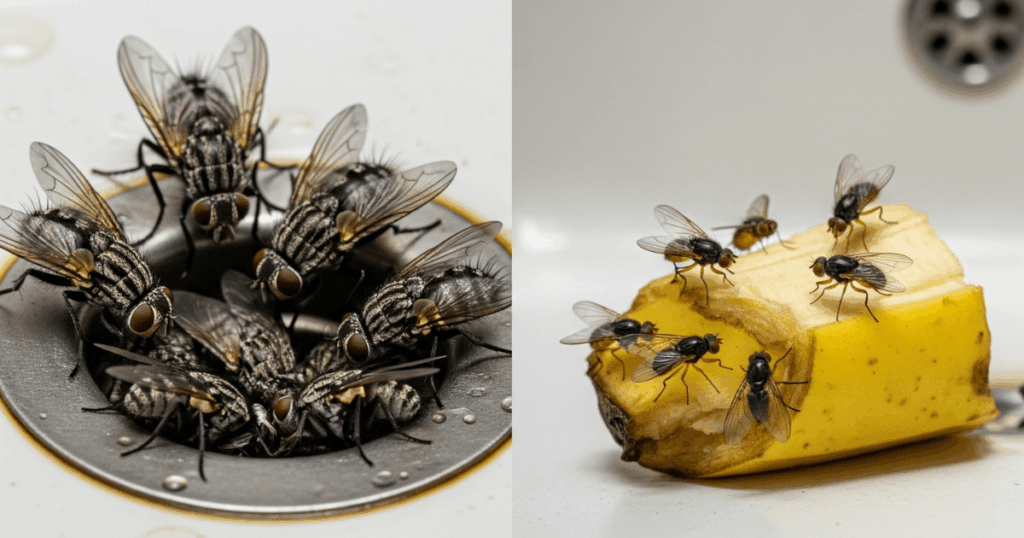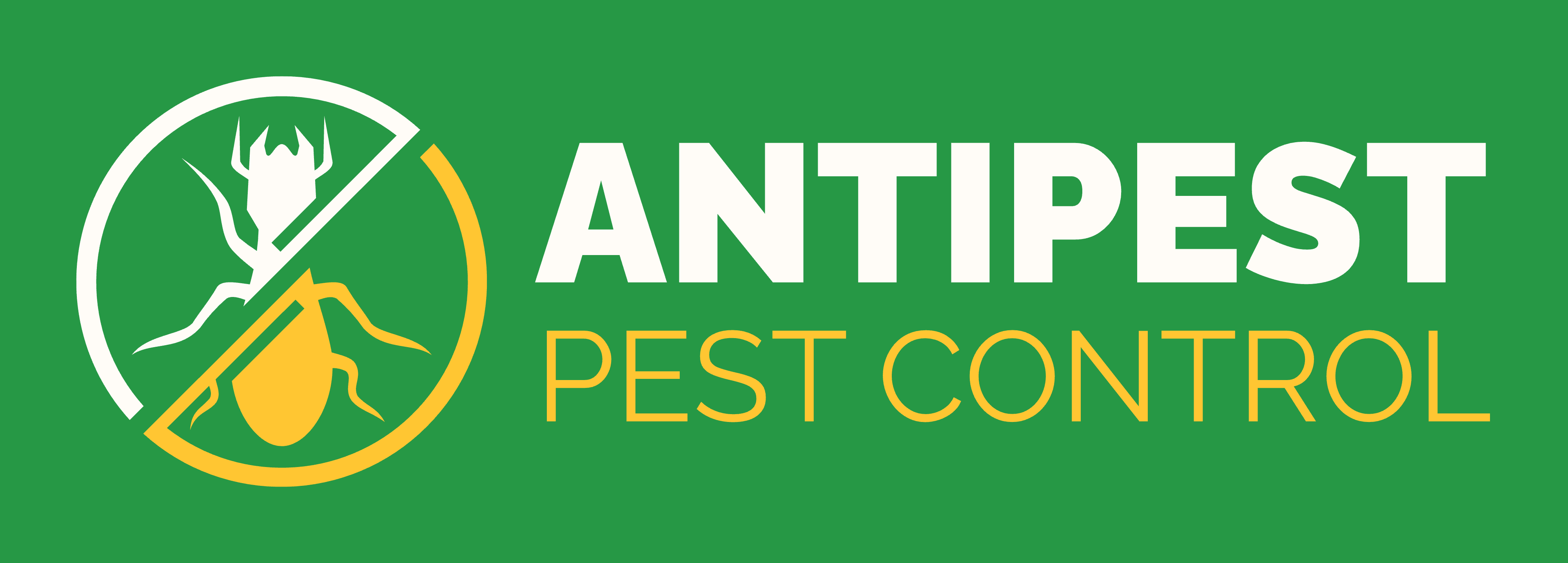Drain flies vs fruit flies are two tiny invaders that show up in kitchens and bathrooms, but they don’t come from the same places and don’t respond to the same fixes, which is why correct identification is essential for fast control. Drain flies vs fruit flies often get confused because both are small, but one is fuzzy and moth-like while the other is smooth with noticeable eyes, and mistaking them can waste weeks on the wrong treatment.
Drain flies vs fruit flies also behave differently, one flutters weakly near sinks and showers, the other darts around fruit bowls and trash, so watching how they move can guide the solution. If the question is “drain flies vs fruit flies, what’s the difference and how do I get rid of them?”, the answer rests on appearance, breeding sites, flight patterns, and sanitation steps that target the actual source, not just the adults.
Table of Contents
Why Comparing Drain Flies vs Fruit Flies Matters?
Many people confuse drain flies with fruit flies because of their small size and flying habits, but these pests thrive in different environments. Drain flies vs Fruit Flies have unique breeding grounds, drain flies usually breed in moist organic buildup inside drains, while fruit flies are attracted to fermenting fruits and kitchen scraps. Because of this, treatments that work for one often do not work for the other. Understanding the difference allows homeowners to target the root of the problem directly, preventing re-infestation and cutting down on frustration and expense.
Key Differences: How to Tell Drain Flies vs Fruit Flies Apart

Distinguishing between drain flies vs fruit flies begins with a close inspection of their bodies, wings, and behavior patterns. Accurate identification is the backbone of successful pest management, as it determines whether you should focus on plumbing or pantry cleanup.
Appearance and Physical Traits
- Drain flies are recognized for their fuzzy, moth-like bodies and dark coloration. Tiny hairs covering their wings and bodies give them a unique “moth fly” look. Their wings tend to be broad, with a fringe, and they usually measure between 1/16 to 1/4 inch in length.
- Fruit flies, in contrast, display a smooth, glossy body and unmistakable bright red eyes. Their bodies range from tan to brown, and they generally measure about 1/8 inch. Fruit flies’ wings are clear and narrow, typically held flat against their back.
Comparison Table: Physical Traits
| Feature | Fruit Flies | Drain Flies |
| Size | 1/8 inch | 1/16 to 1/4 inch |
| Body Texture | Smooth, glossy | Fuzzy, moth-like |
| Eye Color | Bright red | Dark and small |
| Wing Shape | Clear, narrow | Broad, fringed |
| Flight Pattern | Darting, rapid | Fluttering, weak |
| Habitat | Fruit bowls, kitchens | Drains, sinks, moist areas |
How to Get Rid of Drain Flies vs Fruit Flies?
To effectively deal with these pests, it is important to tailor your approach for each:
Getting Rid of Drain Flies
- Clean and scrub drains thoroughly to remove organic buildup using a stiff brush.
- Pour boiling water or a solution of baking soda and vinegar down the drains to eliminate eggs and larvae.
- Use drain cleaners if necessary to clear stubborn debris.
- Set apple cider vinegar traps near drains to catch adult flies.
Getting Rid of Fruit Flies
- Remove overripe or rotting fruits and vegetables from your kitchen promptly.
- Keep countertops and sinks clean from food residues.
- Use vinegar and dish soap traps to attract and trap adult fruit flies.
- Store fruits in sealed containers and regularly take out the trash.
Lifecycle and Habitat Preferences Drain Flies vs Fruit Flies
Understanding the lifecycle and breeding habitats of drain flies vs fruit flies can direct effective cleaning and treatment efforts.
Fruit Flies: Lifecycle & Preferred Habitat
Fruit flies mature rapidly, developing from egg to adult in 8–10 days. A single female may lay up to 500 eggs on fermenting fruit, vegetables, or residue from sugary liquids. Infestations peak in kitchens, pantries, compost bins, and anywhere ripe or decaying produce is left exposed.
Drain Flies: Lifecycle & Preferred Habitat
Drain flies take longer to mature (2–4 weeks) and lay eggs within the slimy biofilm inside drains, pipes, sink traps, and stagnant water locations. Their larvae thrive on the bacteria and organic matter within these moist environments. Homes with unused drains, plumbing leaks, or regularly damp areas are most susceptible.
Lifecycle Comparison Table
| Stage | Fruit Flies (Egg to Adult) | Drain Flies (Egg to Adult) |
| Duration | 8–10 days | 2–4 weeks |
| Egg Deposition | On fermenting foods | In drain biofilm/sludge |
| Larval Diet | Decaying fruits, vegetables | Bacteria, organic pipeline matter |
| Common Habitat | Kitchens, pantries | Drains, sinks, bathrooms |
Key Behavioral Differences Between Drain Flies vs Fruit Flies
Observing fly activity can be decisive in identifying drain flies vs fruit flies. Drain flies are weak, fluttering fliers and often “hop” short distances, mainly crawling on walls near drains. By contrast, fruit flies dart swiftly, changing direction abruptly, and tend to form swarms around fruits or food waste.
Patterns to Observe
- Fruit flies: Swarm around fruit bowls and garbage areas; active throughout the day, especially in kitchens.
- Drain flies: Stay close to drains and moist sites; most active during evening hours; weak fliers, favor crawling.
Signs of Infestation and Risks Between Drain Flies vs Fruit Flies

Both pests are more annoying than dangerous, but their presence means deeper issues. Fruit flies can carry bacteria from rotting food to counters, and drain flies indicate unsanitary, stagnant water or buildup in your plumbing.
- Fruit flies: Spread foodborne bacteria; require a swift cleanup.
- Drain flies: May cause allergies in sensitive people; often indicate underlying pipe problems.
Risks and Health Concerns
Are drain flies vs fruit flies actually harmful? The answer is mostly “not directly,” but they signal hygiene issues and can cause indirect harm. Both types of flies are primarily nuisance pests rather than significant health threats, but large populations can signal bigger hygiene or moisture problems. Health Concerns Fruit Flies
- Indirect disease risk: Can carry bacteria such as E. coli, Salmonella, and Listeria on their bodies and legs.
- Food contamination: Spread bacteria onto surfaces and food items.
Health Concerns Drain Flies
- Allergy potential: Body scales may become airborne and trigger respiratory issues in sensitive people.
- Indicator of unsanitary conditions: Presence may reflect underlying plumbing problems or excessive moisture.
Health Impact Table
| Fly Type | Health Risks | Main Concerns |
| Fruit Flies | Food contamination, bacteria | Sanitation, food safety |
| Drain Flies | Allergies, bacteria exposure | Moisture, plumbing hygiene |
Practical Identification Guide

Drain flies and fruit flies often get confused with fungus gnats and other tiny flying insects. Fungus gnats prefer moist soil in potted plants, and their solution differs. Fungus gnats have clear wings and breed in houseplant soils, not drains or food sources.
Quick Identification Tips
- Drain flies: Moth-like, fuzzy, crawl near drains, slow movement, appear mostly near moist areas.
- Fruit flies: Smooth-bodied, dart rapidly, hover over fruit bowls, often found in kitchen zones.
Differentiation Steps
- Inspect flies for fuzziness (drain flies) versus smoothness (fruit flies).
- Observe flight pattern: are they hopping and fluttery, or darting around quickly?
- Check for red eyes (fruit flies); drain flies have dark eyes.
- Note congregation areas: drains indicate drain flies, food waste signals fruit flies.
Control and Prevention Strategies
The control of drain flies vs fruit flies hinges on targeting breeding sites and removing attractants. Both require sustained effort; missing a breeding spot means the infestation persists.
For Drain Flies
- Clean drains with a stiff brush or drain snake to scrub away slimy biofilm.
- Flush with boiling water to remove loosened debris.
- Use bio-enzymatic cleaners to digest organic material in pipes.
- Repair leaks and reduce humidity in problem areas.
Drain Fly Control Checklist
- Identify drain breeding sites using tape over drains.
- Physically scrub biofilms inside pipes.
- Run water down infrequently used drains weekly.
- Regularly clean drain covers and surroundings.
For Fruit Flies
- Store ripe produce in the refrigerator.
- Remove and discard overripe or spoiled fruits immediately.
- Clean up sugary or sticky spills swiftly.
- Wipe down recycling bins, garbage cans, and under appliances.
- Set vinegar traps: apple cider vinegar plus a drop of dish soap in jars attracts and drowns flies.
Fruit Fly Control Checklist
- Monitor food storage areas, bins, and compost for decaying material.
- Set and maintain vinegar traps near fruit hotspots.
- Practice regular kitchen sanitation, especially during summer and fall.
Comparative Solutions Table
| Control Step | Fruit Flies | Drain Flies |
| Clean affected area | Food surfaces, bins | Drains, pipes |
| Remove attractants | Ripe fruit, food scrap | Moisture, organic buildup |
| Trap method | Vinegar, wine traps | Tape-over-drain monitoring |
“Discover the surprising differences between red ants vs black ants – and learn which one you should really watch out for!”
Seasonal Activity and Prevention Planning for Drain Flies vs Fruit Flies
Fruit flies and drain flies build up in summer and fall, but each peaks at different times. Targeted seasonal preparation helps minimize infestations.
- Spring: Begin deep cleaning of drains before drain fly season intensifies.
- Late summer: Refrigerate produce before fruit fly populations surge.
- All year: Practice weekly drain maintenance and daily kitchen hygiene.
When to Seek Professional Help for Drain Flies vs Fruit Flies?
Persistent infestations may signal hard-to-reach breeding areas, leaks, or deeper sanitation issues. Pest management professionals identify sources and deliver tailored solutions for resistant populations. Contact a pest specialist if:
- Home methods fail after weeks of effort.
- Flies continue to appear despite visible cleanliness.
- Signs of plumbing leaks, standing water, or structural issues emerge.
For comprehensive and hassle-free Drain Flies vs Fruit Flies removal and long-term pest prevention, trust the professionals at Antipest Office. Visit us at the Antipest Office, Our trained technicians use safe and effective methods to protect your home and business. For service bookings and consultations, call us at +91 9819018398 .
Conclusion: Takeaway on Drain Flies vs Fruit Flies
Addressing drain flies vs fruit flies efficiently depends on meticulous identification, targeted cleaning, and ongoing prevention of breeding sites. Both pests multiply rapidly, responding to favorable conditions with swift population surges. By learning the visible and behavioral distinctions, maintaining regular cleaning habits, and addressing underlying moisture or food waste issues, households and workplaces can remain resilient against future outbreaks of drain flies vs fruit flies.
Choosing an approach based on the specific pest, whether focusing on drains or food sources, ensures that drain flies vs fruit flies don’t become a persistent problem. In the end, the most effective strategy is knowledge-backed action: identify, treat, and prevent a pest-free environment, keeping drain flies vs fruit flies far from your living space.
Drain Flies vs Fruit Flies – FAQs
What’s the main difference between drain flies vs fruit flies?
Drain flies are fuzzy and breed in drains, while fruit flies have smooth bodies and infest fruit and kitchen waste.
How can you identify drain flies vs fruit flies quickly?
Drain flies are moth-like and slow-moving near drains; fruit flies dart rapidly and hover around fruit bowls.
When should a pest professional be called for drain flies vs fruit flies?
If home cleaning and traps fail after several weeks, call a pest expert for hidden or persistent infestations.
How do I prevent drain flies vs fruit flies in my home?
Keep drains clean, dispose of old food, and minimize standing water for full prevention.
What’s the easiest way to tell if it’s drain flies vs fruit flies?
Look for fuzzy moth-like flies near drains (drain flies) or smooth, red-eyed flies near fruits (fruit flies).
Which are more harmful – drain flies vs fruit flies?
Fruit flies can spread bacteria to food; drain flies are more of a plumbing nuisance.
How do I spot drain flies vs fruit flies?
Look for fuzzy moth-like bodies near drains (drain flies) or smooth red-eyed flies around fruit (fruit flie
What is the quickest way to tell drain flies vs fruit flies apart?
Look for fuzz and flight: drain flies are fuzzy and flutter near drains, while fruit flies are smooth with red/dark eyes and dart around food sources.
What is the quickest way to tell drain flies vs fruit flies in a home?
Check fuzz, eyes, and location. Drain flies look fuzzy and linger by drains, while fruit flies look smooth with red/dark eyes around fruit, compost, and trash.
How do you get rid of drain flies vs fruit flies effectively?
For drain flies, scrub drains, treat biofilm with enzyme cleaners, and manage moisture. For fruit flies, discard/cover produce, deep-clean bins/disposals, and use apple-cider-vinegar traps.

